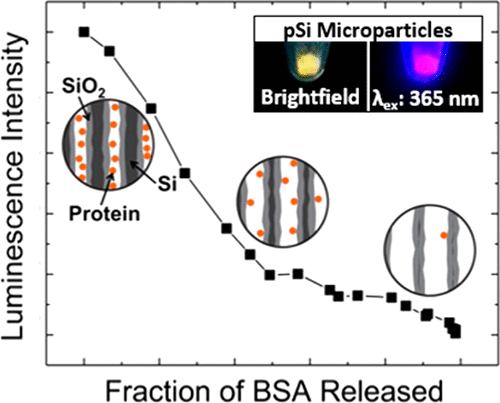当前位置:
X-MOL 学术
›
ACS Appl. Mater. Interfaces
›
论文详情
Our official English website, www.x-mol.net, welcomes your
feedback! (Note: you will need to create a separate account there.)
Self-Reporting Photoluminescent Porous Silicon Microparticles for Drug Delivery
ACS Applied Materials & Interfaces ( IF 8.3 ) Pub Date : 2018-01-16 00:00:00 , DOI: 10.1021/acsami.7b09071 Joanna Wang , Tushar Kumeria 1 , Maria Teresa Bezem 2 , Jian Wang 3 , Michael J. Sailor
ACS Applied Materials & Interfaces ( IF 8.3 ) Pub Date : 2018-01-16 00:00:00 , DOI: 10.1021/acsami.7b09071 Joanna Wang , Tushar Kumeria 1 , Maria Teresa Bezem 2 , Jian Wang 3 , Michael J. Sailor
Affiliation

|
A porous Si (pSi) microparticle-based delivery system is investigated, and the intrinsic luminescence from the particles is employed as a probe to monitor the release of a model protein payload, bovine serum albumin (BSA). The microparticles consist of a core Si skeleton surrounded by a SiO2 shell. Two types of pSi are tested, one with smaller (10 nm) pores and the other with larger (20 nm) pores. The larger pore material yields a higher mass loading of BSA (3 vs 20%). Two different methods are used to load BSA into these nanostructures: the first involves loading by electrostatic physisorption, and the second involves trapping of BSA in the pSi matrix by local precipitation of magnesium silicate. Protein release from the former system is characterized by a burst release, whereas in the latter system, release is controlled by dissolution of the pSi/magnesium silicate matrix. The protein release characteristics are studied under accelerated (0.1 M aqueous KOH, 21 °C) and physiologically relevant (phosphate-buffered saline, pH 7.4, 37 °C) conditions, and the near-infrared photoluminescence signal from the pSi skeleton is monitored as a function of time and correlated with protein release and silicon dissolution. The thickness of the Si core and the SiO2 shell are systematically varied, and it is found that the luminescence signature can be tuned to provide a signal that either scales with protein elution or that changes rapidly near the end of useful life of the delivery system. Although payload release and particle dissolution are not driven by the same mechanism, the correlations between luminescence and payload elution for the various formulations can be used to define design rules for this self-reporting delivery system.
中文翻译:

自报告的光致发光多孔硅微粒用于药物输送
研究了基于多孔Si(pSi)微粒的传递系统,并将微粒的固有发光用作探针来监测模型蛋白有效载荷牛血清白蛋白(BSA)的释放。微粒由被SiO 2包围的核心Si骨架组成壳。测试了两种类型的pSi,一种具有较小的(10 nm)孔,另一种具有较大的(20 nm)孔。较大的孔材料会产生较高的BSA质量负载(3%对20%)。两种不同的方法用于将BSA加载到这些纳米结构中:第一种方法是通过静电物理吸附进行加载,第二种方法是通过局部沉淀硅酸镁将BSA捕获在pSi基质中。从前者系统释放的蛋白质以爆发释放为特征,而在后者系统中,释放是通过pSi /硅酸镁基质的溶解来控制的。在加速(0.1 M KOH水溶液,21°C)和生理相关(磷酸盐缓冲盐水,pH 7.4,37°C)条件下研究蛋白质的释放特性,监测来自pSi骨架的近红外光致发光信号随时间的变化,并与蛋白质释放和硅溶解相关。硅芯和硅的厚度2个外壳系统地变化,并且发现可以调节发光信号以提供一种信号,该信号随蛋白质洗脱而缩放,或者在输送系统使用寿命即将结束时迅速变化。尽管有效载荷的释放和颗粒的溶解不是由同一机制驱动的,但各种配方的发光和有效载荷洗脱之间的相关性可用于定义此自报告传输系统的设计规则。
更新日期:2018-01-16
中文翻译:

自报告的光致发光多孔硅微粒用于药物输送
研究了基于多孔Si(pSi)微粒的传递系统,并将微粒的固有发光用作探针来监测模型蛋白有效载荷牛血清白蛋白(BSA)的释放。微粒由被SiO 2包围的核心Si骨架组成壳。测试了两种类型的pSi,一种具有较小的(10 nm)孔,另一种具有较大的(20 nm)孔。较大的孔材料会产生较高的BSA质量负载(3%对20%)。两种不同的方法用于将BSA加载到这些纳米结构中:第一种方法是通过静电物理吸附进行加载,第二种方法是通过局部沉淀硅酸镁将BSA捕获在pSi基质中。从前者系统释放的蛋白质以爆发释放为特征,而在后者系统中,释放是通过pSi /硅酸镁基质的溶解来控制的。在加速(0.1 M KOH水溶液,21°C)和生理相关(磷酸盐缓冲盐水,pH 7.4,37°C)条件下研究蛋白质的释放特性,监测来自pSi骨架的近红外光致发光信号随时间的变化,并与蛋白质释放和硅溶解相关。硅芯和硅的厚度2个外壳系统地变化,并且发现可以调节发光信号以提供一种信号,该信号随蛋白质洗脱而缩放,或者在输送系统使用寿命即将结束时迅速变化。尽管有效载荷的释放和颗粒的溶解不是由同一机制驱动的,但各种配方的发光和有效载荷洗脱之间的相关性可用于定义此自报告传输系统的设计规则。











































 京公网安备 11010802027423号
京公网安备 11010802027423号